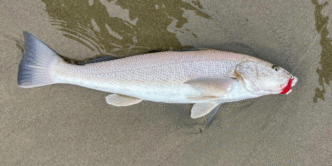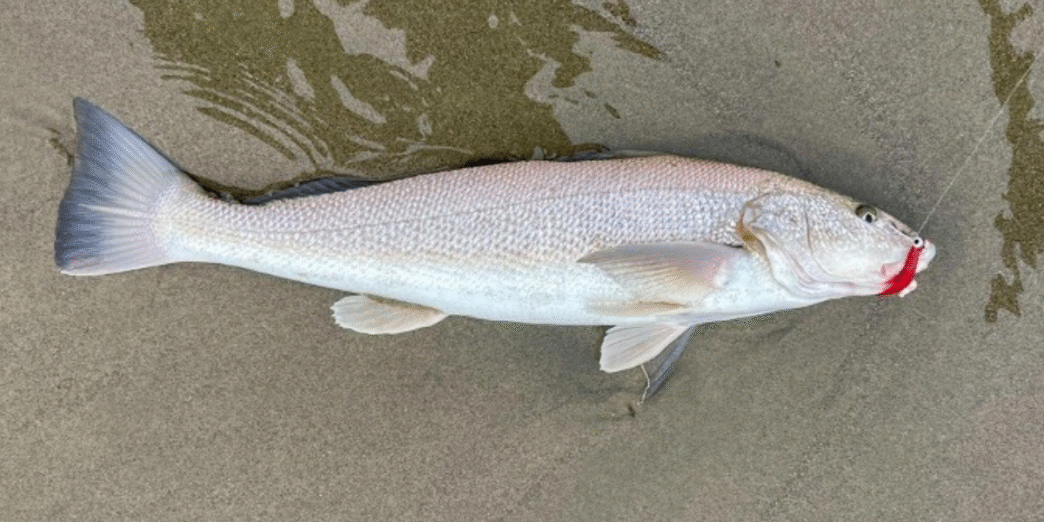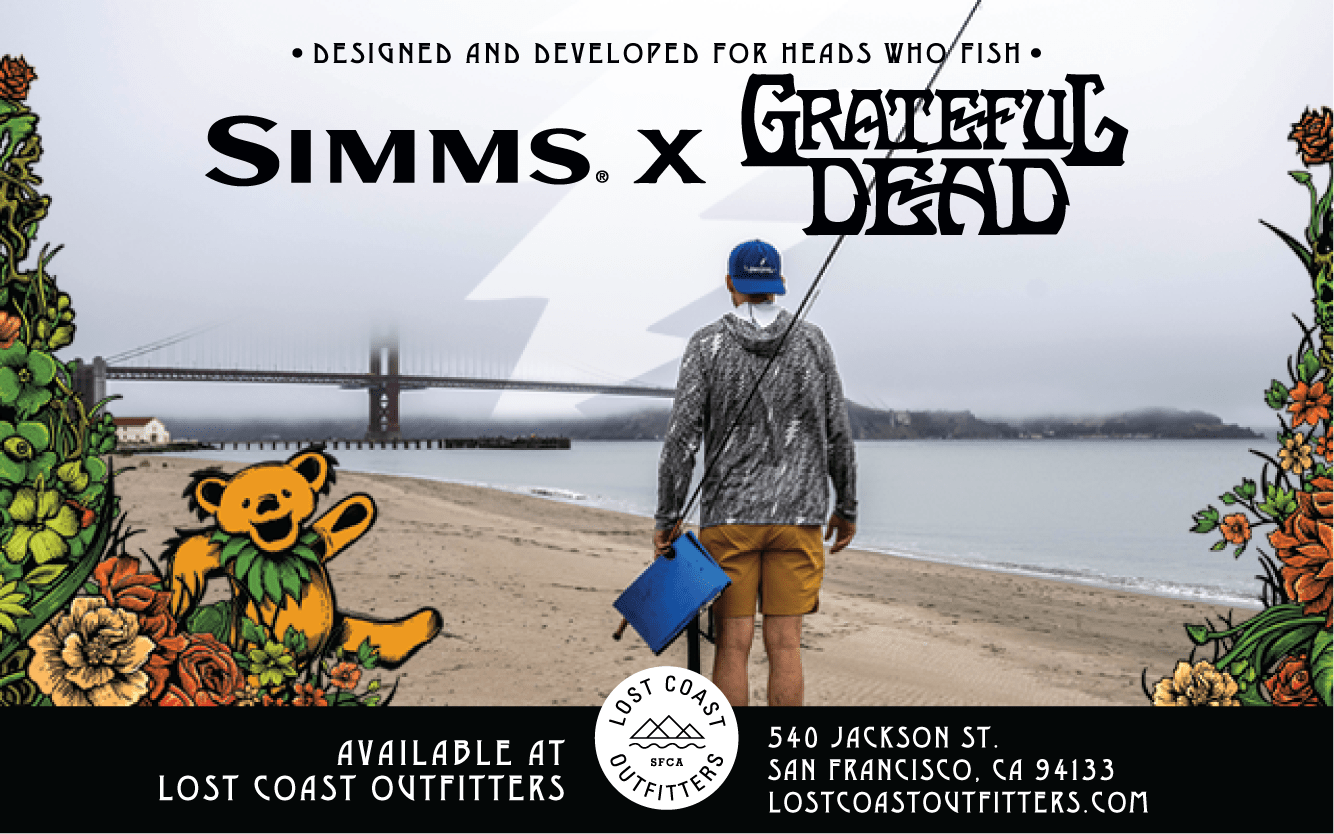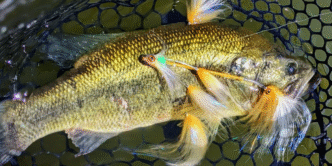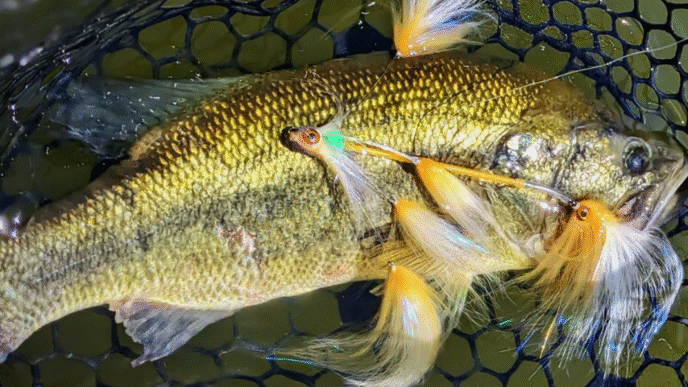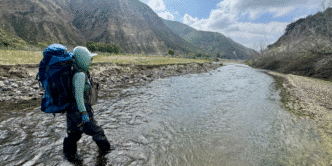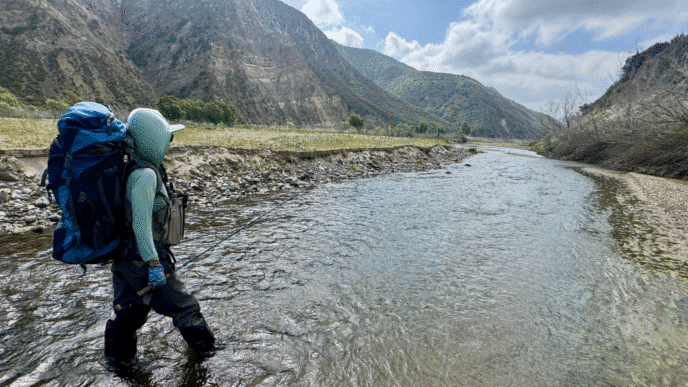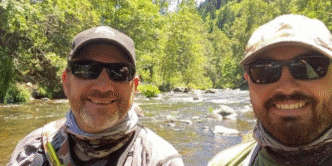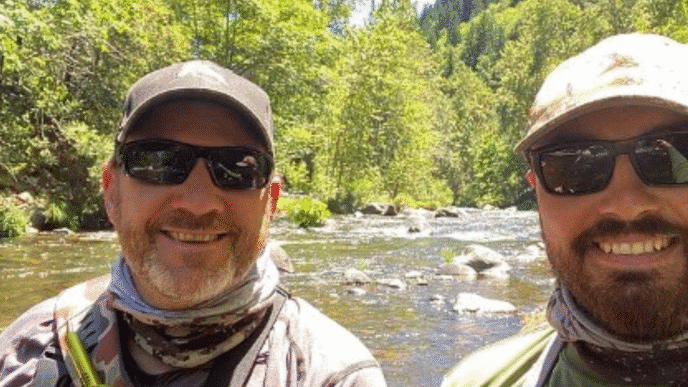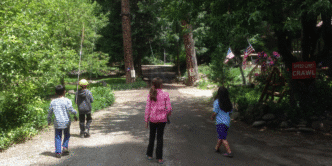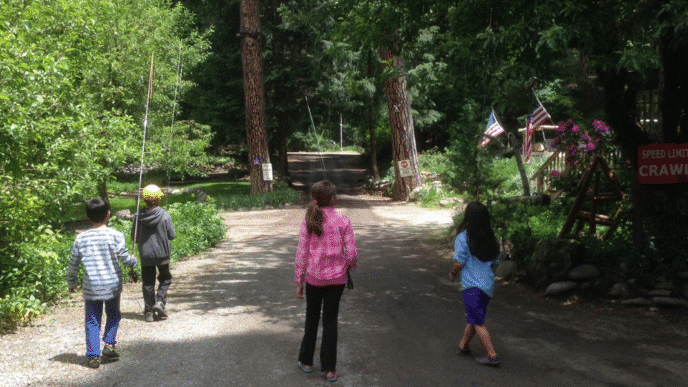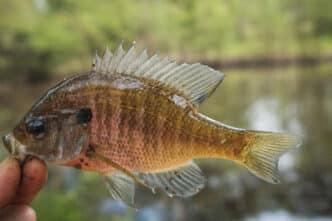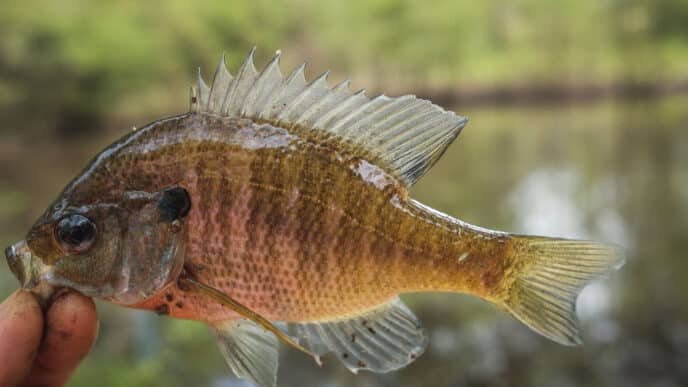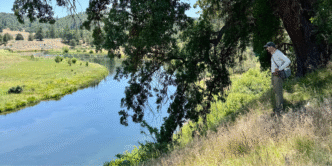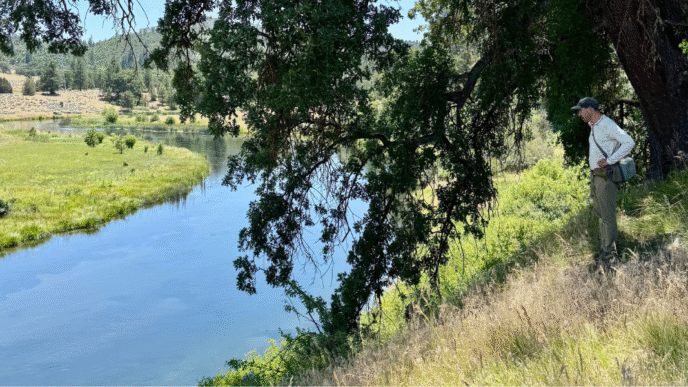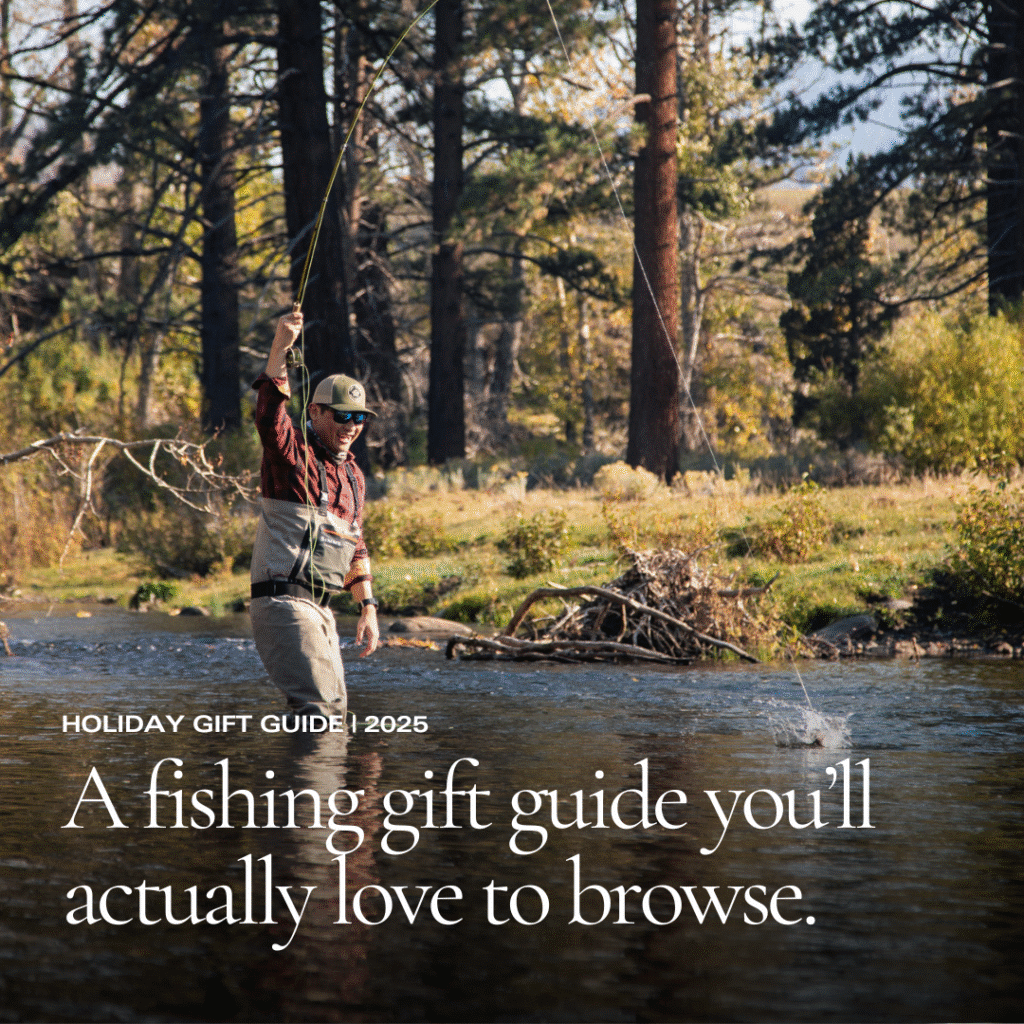EXPLORING THE REGION’S SALTWATER FISHING OPPORTUNITIES—PART III
Summertime Ghosts
My introduction to saltwater fishing began in our local surf pursuing pugnacious barred perch, burly spotfin croaker, and the occasional corbina. My father and I would go almost every Sunday, catching our own sand crabs (mole crabs) for bait below local piers. It was below Redondo Beach’s venerable Monstad Pier that I caught a glimpse of my future as a large glittery California corbina (Menticirrhus undulatus) swirled just behind my galvanized sand crab trap. Flustered with eyes bulging, I asked Dad what it was, and he just shook his head, giving me an indication as to this species’ difficult and spooky nature. I was only ten years old, but that moment left an indelible impression. Though I never attempted to catch one on the fly, I did take free fly-casting lessons that April at the legendary Long Beach Casting Club. It was 1968.
In 2013, almost five decades later, and now well into my fly-fishing journey, my wife and I had just returned from a successful trip to Belize for bonefish, when I spotted a corbina once again! Standing well above the water line on a local beach, I observed a very large one sliding up with the push of larger “set” waves, mouth blinking white as it fed on a crab bed, then promptly sliding back down into deeper water as the wave receded.
I watched for an hour with others joining in for the show until conditions made spotting them in the foamy surge impossible. I’m sure they were there, but I could no longer see them. That experience triggered an obsession that has not wavered, hunting for the summertime ghosts. In that first season, I made exactly thirty-six corbina trips and landed only three on the fly, but I felt like I had hit the jackpot! Those childhood trips with Dad taught me to read the water, undoubtedly helping me land and release my 400th corbina recently. All caught “sightfishing” with the fly, they include three IGFA Fly Rod World Records on 4, 12, and 16# tippet. I love teaching, and for the past decade, I’ve added guiding, classes, and seminars to my summer schedule.
I make the distinction of “sightfishing” because, unlike bait fishing, where you can rely on scent, you stalk these fish before you cast. We need to assess direction and speed, then lead them, deploying a retrieve and cadence that entices a grab. We call that “feeding” them.
Finding structure is absolutely fundamental to being successful with corbina, whether it be troughs, pools, holes, rips, or simply open areas with an abundance of sand crabs, their favorite food. Combining structure with food will increase your odds significantly. Tides play an extremely important role in finding structure, so I arrive at the beach during low tide so that its features can be noted and fished once the tide fills them in.
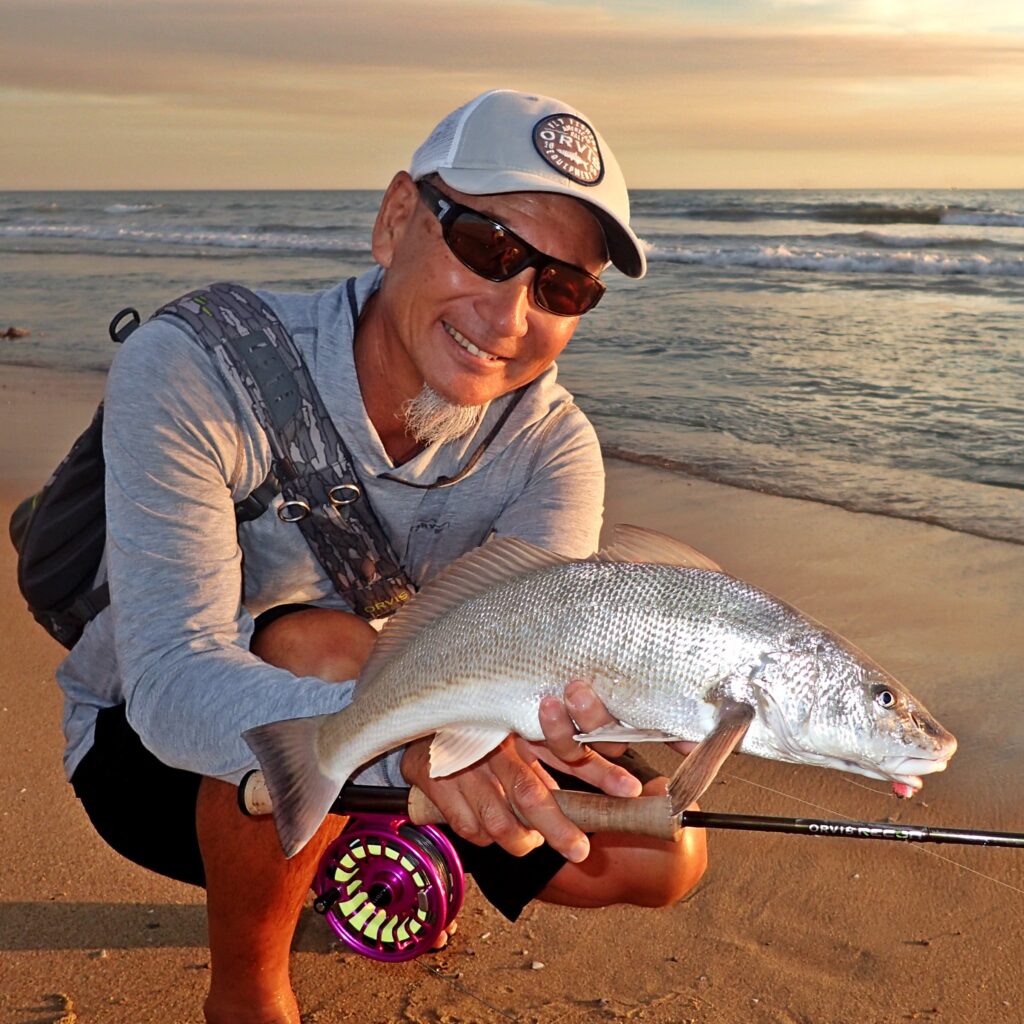
EQUIPMENT
Wearing polarized sunglasses (like Costa copper lenses) and standing well back out of the water, watch for them to cautiously glide in with the waves, looking for food. Smaller surf is preferable, and like so many predatory species, they are most comfortable in low light. At dawn and dusk, you might even see a tail or a back as they feed in extra shallow, ankle-deep water. I’ve guided fly anglers from all over the world, and they all say that this is as visually exciting as chasing flats bonefish, permit, and redfish.
While that same 5-weight outfit you use for trout will suffice, I prefer a six-weight outfit as that will allow more “punch” when casting in breezy conditions. My favorite is an Orvis Helios 6F, which balances perfectly with a Galvan Grip 6. Scientific Anglers’ Sonar Stillwater Seamless Density Sink 5 / Sink 7, a full sinking line, will keep your presentation on the bottom where they find their food and feed. In the dynamic line-bending surf environment, it is vital that your presentation maintains a straight-line path to your fly so that you can move your fly effectively and feel subtle takes. More abrasion resistant, less visible, and faster sinking than monofilament, an 8’ section of straight 10# SA Absolute fluorocarbon completes your rigging.
Regarding fly patterns, the Surfin’ Merkin remains the gold standard. None have proven better. If you choose to tie your own version, I recommend Gamakatsu B10S hooks in size 6, bead chain or lead dumbbell eyes, Enrico Puglisi fibers in salmon pink and silver grey, and silicone legs. Take the time to observe how live sand crabs move, which will better inform your crab’s design. On occasion, you will see corbina pushing baitfish along the beach. At those times, I have done well with a small Clouser minnow.
TACTICS
Corbina have soft but tough mouths, and it is not unusual to miss over half of your eats as they eat, then quickly reject your offering. Tying or buying your flies on ultra-sharp hooks can up your odds. If you see or feel a take, resist setting the hook by lifting the rod (a.k.a. the dreaded “trout set”). Instead, using a strip strike (long, continuous strip to your side) will help drive the hook into the fish’s mouth more effectively, and if missed, it will keep the fly in the water where the fish can have a follow-up pass. Once hooked, keep stripping until you feel the weight of the fish as it turns and heads away. Clearing the line from your stripping basket is your next priority. Once done, let your already set drag (2-3#) squeal and enjoy the battle!
Corbina usually feed along the beach into the current. Doing so keeps sand and debris flowing behind them as they swim forward, making for a clear feeding lane ahead. Once spotted, I shift my gaze ahead and deploy an angled intercepting cast, whereby I land the fly softly approximately three feet ahead and three feet past my target then use a retrieve that creates the illusion that the crab fly, usually a Surfin’ Merkin, was spooked by the oncoming corbina.
A short prompt, 6-12” pop-pop-pop style retrieve is often effective, so start there, then experiment. Always keep your rod pointed straight down your fly line for maximum contact (I like my tip on the sand). It’s worth mentioning that if you’ve not cast a full sinking fly line before, it may feel somewhat heavy, thus requiring a more “open loop” to prevent the line from crashing into the water and spooking every corbina on the beach. Consistent casting practice, especially into the wind, will pay dividends.
SEASONALITY AND LOCATION
Corbina range from Point Conception to the border with Mexico, providing an area almost 200 miles long, except for those uninhabited rocky areas or those off-limits to sportfishing. For those venturing further south, they have been found in abundance in Magdalena Bay, within Baja coastal estuaries, and at the famous surf spot, Scorpion Bay. They mostly prefer sandy areas but can also be found cruising the back bays over mud searching for ghost shrimp and clams.
We typically begin seeing corbina in targetable numbers in June, with peak season being July and August. They begin to depart with the first northern storms in the fall as water temperatures drop. However, in El Niño years, we have caught them all year long. I’ve logged every trip over the past 12 years and the data suggests that corbina prefer water temperatures in the 64-68 degree range and that they gather up to spawn on the full moon. That said, I’ve caught them during a March heatwave and a December chill. It never hurts to go to the beach and look, regardless of the time of year.
In season, you can visit almost any flat sand beach in Santa Barbara, Ventura, Los Angeles, Orange, and San Diego Counties and have a reasonable chance at finding corbina. Of course, our beaches can become crowded with beachgoers as the day progresses, so focus your efforts early and late in the day. However, different beaches fish best at different stages of the tide, so don’t be afraid to vary the timing of your visits. Our beaches are shared resources for all to enjoy, so be prudent, as non-fishers have a habit of standing or walking directly into your fly line’s path. That said, pinch those hook barbs to minimize damage to the fish and others.
WORTH THE PURSUIT
California corbina are far from easy. If you’ve pursued finicky Hawaiian bonefish before, you can expect that kind of challenge and effort in order to be successful. With this species in particular, time on the water is everything. I have a friend who is a master at fly fishing for coveted flats permit, with over 400 to his name, and he swears corbina are much more difficult. Are they worth pursuing? ABSOLUTELY! Where else are you going to find a challenging world-class species only a few miles from our So Cal home?
You can read Glenn’s in-depth article about hunting calico bass titled “Midnight Madness” in the Winter 2025 issue.



